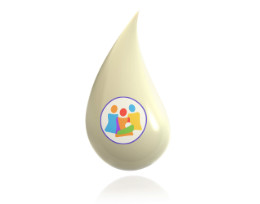Working and Lactation
Updated 04/22
PDF Version
Return to Work Recommendations for a Lactating Parent
- Let your employer know of your pumping and breastfeeding needs before you return to work. Inform your employer about how often you will need to pump, and how long you expect pumping will take. You may be planning to have your baby brought to you for feeding, or you may want to change your work schedule so that you can go home or to the daycare for lunch, in order to breastfeed. Also, you may want to discuss returning to work part-time for the first 1-2 weeks, to get the hang of pumping and being away from the baby.
- Find a supportive daycare that will support your efforts to continue nursing and is comfortable with human milk storage and handling. For example, a supportive daycare provider will communicate with you at the end of the day if the baby is hungry, for direction on whether they should feed the baby or wait for you to pick up the baby. They will also support paced-bottle feeding and understand how to avoid overfeeding babies. They also acknowledge that breastfed babies drink smaller volumes less often than formula fed babies.
- If the employer does not have a lactation program, share information about the US Federal Break Time for Nursing Mothers Law.
- Find out from the employer if any other people have pumped milk at work, in order to learn tips from colleagues.
- Take as much parental leave as possible to recover from delivery, and to establish a strong breastfeeding relationship. Your job during your leave is to recover, establish your milk production, and bond with and learn to care for your baby. This is not a vacation and you are not taking a break from work – you are taking a medically necessary leave. Take as much time as possible so you can recover and care for your baby.
- You will want to store milk in the freezer in preparation for your first day back to work. Consider expressing a small volume of milk several days a week, starting about 3-4 weeks before returning to work. It is best to express milk immediately after a feeding, which avoids taking milk away from the baby for the next feeding. Many people will hand express or pump immediately after their first morning feed when milk production is highest. Try to avoid removing more than 2-4 oz (60-120ml) per day, since the extra milk expression can drive up milk production and increase the risk of mastitis and/or plugged ducts. Once you have collected 2-4 oz (60-120ml) in the refrigerator, label it with the date of the oldest expressed milk and freeze it in bottles or bags. Aim to provide a minimum of 1-1.5 oz (30-45ml) for every hour that you will be gone. Many people provide 10-15 oz (300-450ml) of frozen/fresh milk for the first day back to work. See our handout on Human Milk Storage
- Consider introducing a bottle to the baby before going back to work. It may be helpful for the lactating parent to be out of the house when the bottle is introduced. If possible, see if the caregiver or daycare provider can practice bottle feeding the baby before going back to work. If your baby does not take the bottle, do not stress! See our Handout on Bottle Refusal.
- Plan your pumping schedule before you go back to work. Try to pump at least every 3 hours if the baby is under 6 months, unless the baby breastfeeds less often such as every 4 hours. Many parents find a mid-morning session, a lunchtime session, and a mid-afternoon session to be adequate. Some parents also pump prior to starting their work day and/or at the end of the day if they have a long commute. You may be able to pump less often you have high milk production. The goal is to pump a minimum of 1-1.5 oz (30-45ml) for every hour that you and the infant are separated. Feed this freshly expressed milk the following day. Fresh milk is higher in protein, vitamins, antioxidants, and has antibodies against any germs that you and the baby have encountered in the last few days. Frozen milk is still excellent, but second best to fresh milk.
- Use a good quality double electric pump at work that will do allow you to finish milk expression in 12-15 minutes. Some employers have dedicated rooms with hospital grade pumps. Make sure you are comfortable using the pump before going back to work.
- If the employer does not have a space designated for pumping, work with your employer or supervisor to find a private place at work. The room should be private, secure, have an electrical outlet and ideally a sink for washing hands and pump parts. The bathroom is never an acceptable place to express milk since it is unsanitary. The Federal Labor Standards Act states that employees should never be expected to express milk in the bathroom.
- Find out from your employer where you can store your expressed breastmilk. If there is no refrigerator at work, a cooler with cold packs works well. If there is a refrigerator, there is no concern for your milk ‘infecting’ food or other products in the refrigerator. However, you might feel most comfortable placing your milk in a lunch bag in the refrigerator, so that the milk is not inadvertently spilled or tampered with in any way.
- Several tips to promote letdown during pumping include:
-
- Think about the baby in order to relax. Bring a photo, an article of baby clothing, an audio recording, a blanket, or a toy.
- Try to sit and relax in a comfortable position, ideally in a place that won’t be interrupted by others.
- Lightly massage or tickle the breasts and rub the nipples before pumping to promote letdown.
- Try to enjoy your pumping break! Treat yourself to a special snack, favorite music, or an engaging book, unless you feel compelled to keep up with work tasks to avoid having to stay late.


